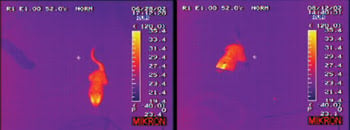
Squirrels use IR signal to protect their turf against hungry rattlers
Investigators have found that a certain species of squirrel has a defensive signal so powerful that it can keep at bay even the much-feared rattlesnake.
The survival secret of the California ground squirrel (Spermophilus beecheyi) is its tail, according to researchers from the University of California, Davis. They reported in the Aug. 17 online edition of PNAS that, when the small mammal vigorously shakes its tail in the presence of a rattlesnake, infrared radiation is emitted in the process. The rattlesnake species Crotalus oreganus can detect the radiation and, in many cases, shifts from a predatory to a defensive posture.

Infrared video frames of a squirrel encountering a rattlesnake (left) and a gopher snake (right). The squirrel’s tail emits considerably more radiation in the encounter with the rattlesnake. The squirrel’s head is obstructed by the cage in the bottom image. Reprinted with permission of PNAS.
Moreover, it appears that the squirrel has the ability to turn its infrared mechanism on and off, depending on the situation. When the same squirrel species is confronted by the gopher snake (Pituophis melanoleucus), it still shakes its tail but does not emit anywhere near the same level of infrared radiation. The gopher snake does not have the capacity to detect such signals; thus, the squirrel would be producing the radiation for nothing.
The findings suggest that the ground squirrels, over millions of years, have developed species-specific signals to aid in their survival. In this case, it seems that the squirrels are countering an adaptation of the rattlesnake — infrared-sensitive pit organs — by generating an abundance of infrared radiation.
The researchers, led by Aaron S. Rundus, theorize that the snakes might become confused as they process the radiation coming from the tail. It is possible that the radiation convinces them that the squirrel is too big to attack. It also enhances the conspicuousness of the tail-flagging signal. Rattlesnakes hunt by ambush, and seeing the tail signal is an indication that their cover has been blown.
To test their findings, the researchers used a robotic squirrel (realistic models outfitted with heated tails and stored in squirrel bedding to provide the proper odor) as well as live squirrels separated from live snakes (both rattlesnakes and gopher snakes) by a wire mesh to prevent contact. A Mikron infrared imaging video camera was used to analyze the encounters with the live squirrels.
The researchers hypothesize that squirrels may produce the infrared radiation by increasing the blood flow from their body to their tail. Such thermoregulation is common in small rodents.
Published: September 2007